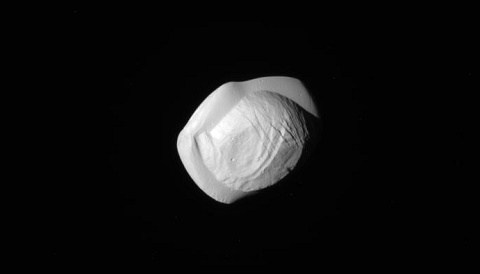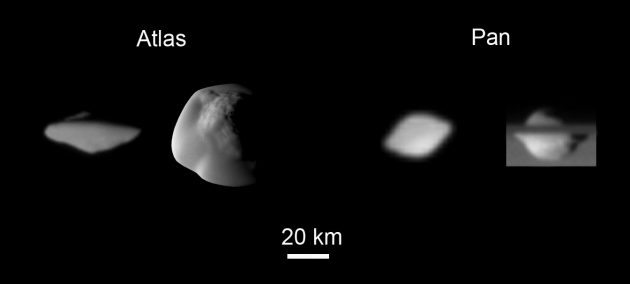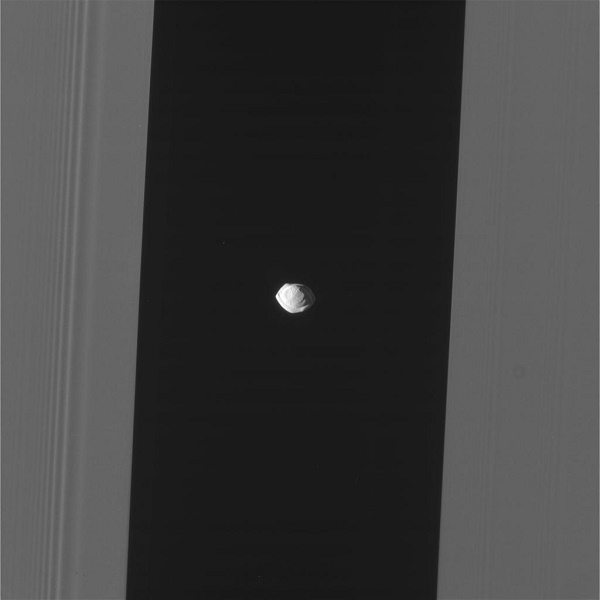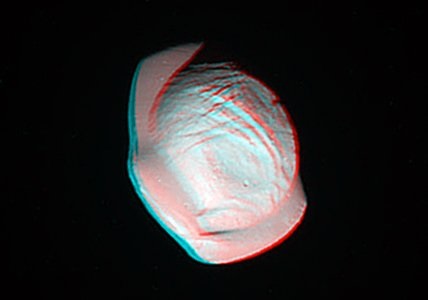Cassini gave us a good look a Saturn's moon Pan last week . . . and what a strange world it is.

NASA / JPL-Caltech / Space Science Institute
Who ordered that? The universe served up a piece of astro-pareidolia last week, when humanity got its first closeup look at Saturn's tiny moon Pan. Appropriately named after the half-man, half-goat satyr from Greek mythology, Pan is nestled in the Encke (pronounced EN-key) Gap within Saturn's A ring. NASA's Cassini spacecraft flew just 15,268 miles past the moonlet (closer than the distance to the geosynchronous satellites from Earth) on March 7th.
“Nearing its end, Cassini delights again,” says Carolyn Porco (Space Science Institute) on Twitter. “Here is 35-km Pan in mind-blowing detail with its unmistakable accretionary equatorial bulge.”

NASA / JPL-Caltech / Space Science Institute
Mark Showalter (then at Stanford University) discovered Pan on July 16, 1990. Showalter and colleagues first inferred the tiny moon's presence by the waves it kicked up in the wake of its passage through the Encke Gap. After accurately predicting the moon's orbit, Pan was found in 11 images taken by Voyager 2 during its August 1981 flyby.
The moon orbits Saturn every 13.8 hours from an average distance of 134,000 kilometers (80,150 miles), equivalent to about one-third the Earth-Moon distance, and just 73,000 miles from the Saturnian cloud tops), the 34x31x21-kilometer moon carves out the Encke Gap in Saturn's outermost bright A Ring. On Earth, Pan would just barely fit inside Tampa Bay. The moon has an albedo (or reflectance) of 50%, equivalent to dirty snow.
Unlike the narrow 35-kilometer-wide Keeler gap occupied by the tiny moonlet Daphnis, the wider 325-kilometer Encke Gap also hosts a tenuous ringlet that Pan braids and modifies. While the Daphnis is slightly inclined to the plane of Saturn's rings by 0.0036 degrees and kicks up vertical waves in its wake, the orbit of Pan is nearly flat with an inclination of only 0.0001 degrees, and it induces spiral density waves in the ring plane.
Brave Little Moon
For a while now, scientists have had a hunch that there's something askew about Pan and Atlas, based on distant views obtained by Cassini in 2007.

NASA / JPL / Space Science Institute
How did Pan get its strange shape? The leading idea is that the flange of ice around its equatorial bulge is ring material swept up and collected by the moon as it cruises through the Encke Gap.

NASA / JPL-Caltech / Space Science Institute
“Pan got its distinctive “skirt” because of the last stages of its formation (continued even in slow motion today) in which it accreted material from the rings it's embedded within,” says Porco. “During the last stages the rings were very thin and so the material falling onto Pan at this time came down on its equator and built the ridge you see.”
The skirt of ice towers several kilometers above the surface. One can only wonder what sort of alien sky an observer standing next to it would see, with glorious Saturn and the edge-on rings filling the view beyond the frozen wall. Is it rock hard, or soft as newly fallen snow? Or is pasta-shaped Pan just filled with cheesy goodness all the way through?
The release of the images also sparked a flurry of commentary across social media last week. Space fans saw in the moon's bizarre shape anything from a filled pasta, to a space cabbage, to an empanada, perhaps reflecting a true “hunger” out there for space exploration.
“My first impression when I saw the first image? That it was an artist's depiction of what Pan might look like,” says Porco. “It looked so alien and 'well executed,' so to speak, that I didn't think it was real. But the thrill of discovery is why we do this. Cassini, once again, delivered us a wonderful gift!”
Cassini's distant images of Saturn's moon Atlas indicate it's probably similar to Pan. We'll get a good look at that moonlet next month, when Cassini flies just 13,000 kilometers past Atlas on April 12th.

NASA / JPL-Caltech / Space Science Institute
Launched on October 15, 1997, Cassini arrived at Saturn on July 1, 2004. Cassini is currently finishing up a series of twenty ring-grazing orbits, swooping in through the ring plane of Saturn once every seven days. Next month, Cassini prepares for the climax, a series of Grand Finale orbits that will end with the demise of the spacecraft on September 15, 2017, at 8:07 AM EDT (12:07 Universal Time), when it burns up in Saturn's atmosphere.

NASA / JPL-Caltech / Space Science Institute. 3D processing: Jason Major
Strange new worlds such as Pan remind us that there are still bizarre, unexplored corners of the solar system. Cassini promises to give us some dramatic new views of Saturn and its enigmatic moons, right up to the very end.
Read more papers by the Cassini imaging team on Saturn's “saucer-shaped" moons: Saturn's Small Inner Satellites: Clues to Their Origins and The Equatorial Ridges of Pan and Atlas: Terminal Accretionary Ornaments?
 12
12









Comments
Bob
March 14, 2017 at 12:26 am
Most interesting. Really like the photos.
Bob Patrick
Kentucky
USA
You must be logged in to post a comment.
Roger Venable
March 14, 2017 at 9:51 am
Accretion of ring material is proposed as a means by which the circumferential bulge on Pan might have formed. Saturnian moons Atlas and Promethius are also observed to have such equatorial ridges, though not yet imaged so well as that of Pan.
These three moons are all well within the Roche limit. So, how does material accrete to them? Could static electric charges on orbiting particles play a role?
Furthermore, they all have tidally locked rotation periods equal to their periods of revolution. The scenario of a rotating moon with an equatorial accretion disc cannot be applied easily to this situation. Might the equatorial ridges be due to an as yet unrecognized disruptive process rather than an accretive process?
-- Roger Venable
You must be logged in to post a comment.
Peter Wilson
March 19, 2017 at 1:37 pm
Yes. It's a tug-of-war between tidal forces tending to disrupt objects, and chemical forces of very cold ice, plus gravity, trying to hold them together. We're seeing a snapshot. It's not clear to me who's winning.
You must be logged in to post a comment.
Robert-Casey
March 14, 2017 at 2:02 pm
Looks like an old beat up flying saucer spaceship. 🙂
You must be logged in to post a comment.
March 17, 2017 at 6:01 pm
Looks like we have found the Kerwood Derby.
You must be logged in to post a comment.
Jim-Baughman
March 21, 2017 at 12:28 pm
Ha!
“Nuthin’ up my sleeve!”
You must be logged in to post a comment.
March 17, 2017 at 6:06 pm
woops -Kirward Derby. Whatever.
You must be logged in to post a comment.
March 17, 2017 at 6:06 pm
woops -Kirward Derby (spelling). Whatever.
You must be logged in to post a comment.
Vivisurvivor
March 20, 2017 at 1:55 pm
I absolutely loved the 3D image! What fun! I really got a terrific feel for the shape. So cold out there! Thank you so much.
You must be logged in to post a comment.
Jim-Baughman
March 21, 2017 at 12:33 pm
Just below center on the 3D image there lies what appears to be a slushy, elongated crater. Is it possible that the impact of whatever it was—
1. Knocked Pan out of its synchronous orbit lopng enough to collect its “tutu” of icy material
2. The impactor furnished the icy material itself—a slow collusion followed by a low-speed scattering of icy debris, some of which accreted to the ring system, some around the equator of Pan
You must be logged in to post a comment.
Jim-Baughman
March 21, 2017 at 12:36 pm
1. “lopng” s/b long
2. “collusion” s/b “collision” (I’ve been brain-soaked by recent news.)
You must be logged in to post a comment.
J-Callery
April 17, 2017 at 9:35 am
If ring material collected on the leading edge of Pan as it traveled around and not on the trailing edge it would cause the center of gravity to continually move towards the leading edge. Would this not cause a rotation?
You must be logged in to post a comment.
You must be logged in to post a comment.